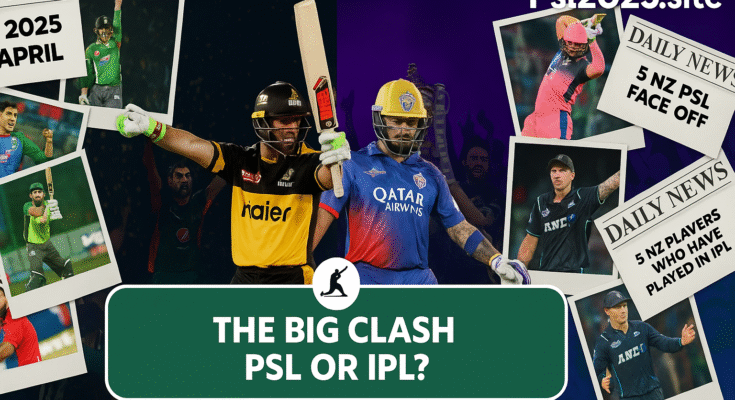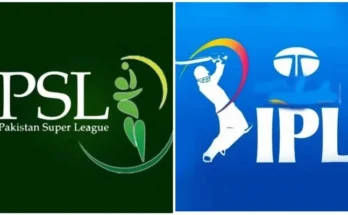PSL 2025 vs IPL 2025: Can Pakistan’s T20 League Shine in the Clash?
The cricketing world is bracing for an unprecedented clash in 2025 as the Pakistan Super League (PSL) and the Indian Premier League (IPL) overlap for the first time in their histories. Traditionally held in February-March, the PSL has shifted to an April-May window (April 11 to May 18, 2025) due to scheduling constraints, including Ramadan and international commitments like the ICC Champions Trophy and T20 World Cup 2026. Meanwhile, the IPL, running from March 22 to May 25, 2025, remains the juggernaut of T20 cricket with its 74-match, 10-team extravaganza. This overlap has sparked debates about viewership, player availability, financial disparities, and whether the PSL can carve out a significant presence in this high-stakes clash. Can Pakistan’s T20 league shine against the IPL’s global dominance, or will it struggle in the shadow of its wealthier rival?
The Context of the Clash
The PSL’s shift to April-May marks a significant departure from its usual calendar, which avoided direct competition with the IPL. The Pakistan Cricket Board (PCB) made this move to accommodate a packed international schedule, but it places the PSL in direct competition with the IPL’s 18th season. The IPL, with its 10 teams playing 74 matches across 13 venues, is a global phenomenon, boasting a brand value of $10.7 billion and media rights worth $6.2 billion. In contrast, the PSL, in its 10th season, operates on a smaller scale with six teams, 34 matches across four venues (Lahore, Karachi, Multan, and Rawalpindi), and a media rights deal of $36 million. Despite its growth—evidenced by 150 million digital views in 2024—the PSL faces an uphill battle against the IPL’s financial and commercial clout.
The scheduling overlap raises questions about viewership and player availability. The IPL’s global audience, estimated at 620 million, dwarfs the PSL’s, and its ability to attract top-tier international talent is unmatched due to higher salaries and prestige. However, the PSL has carved a niche as a competitive, bowling-heavy league, and its supporters argue it can hold its own by offering quality cricket. As Hasan Ali optimistically remarked, “If we play well in the PSL, viewers will leave the IPL to watch us,” emphasizing the potential for standout performances to draw attention.
Financial Disparities: Prize Money and Salaries
One of the starkest contrasts between the two leagues is their financial structures. The IPL’s prize money for 2025 is significantly higher, reflecting its economic muscle. The IPL champions are expected to earn around INR 20 crore (approximately $2.4 million), with a multi-layered reward system that benefits even lower-ranked teams. In contrast, the PSL champions will receive $500,000 (PKR 14.07 crore), with runners-up earning $200,000, and no additional payouts for other teams. This disparity underscores the IPL’s ability to distribute wealth across its franchises, while the PSL adopts a more focused approach, prioritizing the finalists.
Player salaries further highlight the gap. The IPL’s 2025 auction saw Rishabh Pant become the most expensive player in its history, signed for INR 27 crore by Lucknow Super Giants, followed by Shreyas Iyer at INR 26.75 crore for Punjab Kings. The highest-paid players in the IPL, such as Venkatesh Iyer (INR 23.75 crore) and Yuzvendra Chahal (INR 18 crore), command salaries that dwarf those in the PSL. In the PSL, the top salary in the Platinum category is $300,000 (approximately INR 2.57 crore), with players like David Warner (Karachi Kings), Shaheen Afridi, and Babar Azam earning around this amount. While the PCB has increased salaries for 2025 to remain competitive, the IPL’s financial rewards remain unparalleled, making it the preferred destination for many international stars.
Player Availability and Squad Strength
The overlap poses challenges for player availability, as top international players often prioritize the IPL due to its higher pay and global exposure. The PSL has managed to attract notable overseas talent for 2025, including David Warner, Kane Williamson, Finn Allen, and Michael Bracewell, but the IPL’s roster is stacked with marquee names like Virat Kohli, Jasprit Bumrah, and Pat Cummins. Ricky Ponting, Punjab Kings’ coach, noted that the PSL’s timing complicates finding replacements for injured IPL players, as many quality players are committed to Pakistan. This suggests the PSL retains some pull, but the IPL’s deeper talent pool gives it an edge.
The PSL’s strength lies in its bowling, often praised as superior to the IPL’s. Wahab Riaz highlighted that “the kind of bowlers you get in the PSL is not found in other leagues, not even in the IPL,” pointing to high-quality pacers like Shaheen Afridi, Naseem Shah, and Hasan Ali. The PSL’s pitches, which offer more for bowlers, result in lower-scoring, competitive matches compared to the IPL’s flatter tracks, where high-scoring games are common. For instance, PSL 2025 has seen standout bowling performances, such as Alzarri Joseph and Luke Wood decimating Lahore Qalandars to 44/6 in a recent match. In contrast, IPL matches like Gujarat Titans’ 224/6 against Sunrisers Hyderabad reflect its batting-friendly conditions.
Viewership and Fan Engagement
Viewership is a critical battleground. The IPL’s 620 million viewers and massive digital reach give it a significant advantage. Its matches, broadcast across multiple platforms and backed by Bollywood glamour, attract a global audience. The PSL, with 150 million digital views in 2024, has a strong domestic following and growing international interest, particularly in the Middle East and among the Pakistani diaspora. However, the overlap could split viewership, especially in markets where both leagues are popular.
The PSL is countering this with strategic moves, such as adjusting match timings to avoid direct clashes with IPL games. Most PSL matches are scheduled at 8:00 PM PKT (3:00 PM GMT), while IPL games often start at 7:30 PM IST (2:00 PM GMT), minimizing overlap. Additionally, the PSL’s “Luminara” trophy unveiling, nationwide trophy tour, and anthem “X Dekho” have generated buzz, engaging fans across Pakistan. The IPL, however, relies on its star power and high-profile opening ceremonies, like the Kolkata Knight Riders vs. Royal Challengers Bengaluru clash at Eden Gardens, to maintain its spectacle.
Sentiment on platforms like X reflects the rivalry. Some fans, like @Usama7, claim the PSL’s quality could overshadow a “10-team IPL” perceived as featuring “average players.” Others, like @Ideepakkharwar, argue the IPL’s revenue generation far outpaces the PSL, which faces challenges like empty stadiums and financial constraints. The PSL has also faced criticism due to boycott campaigns targeting sponsors like KFC and Pepsi over Pro-Palestinian sentiments, potentially impacting attendance. In contrast, the IPL’s packed stadiums and robust ticketing system ensure strong gate revenue.
Competitive Landscape and On-Field Action
On the field, both leagues are delivering thrilling cricket. After 11 matches in PSL 2025, Islamabad United lead the points table with an unbeaten run, driven by players like Andries Gous and Shadab Khan. Multan Sultans, however, are struggling, winless in their first three games. The IPL’s points table is more dynamic, with Mumbai Indians climbing to the top after a 100-run thrashing of Rajasthan Royals, powered by Ryan Rickelton and Jasprit Bumrah. The IPL’s 74-match format allows for more twists, while the PSL’s compact 34-match schedule ensures intense competition.
The PSL’s competitive edge lies in its unpredictability and bowling dominance. Matches like Peshawar Zalmi’s seven-wicket win over Lahore Qalandars, anchored by Babar Azam’s fifty, showcase its ability to produce nail-biting contests. The IPL, with its high-scoring encounters, appeals to fans seeking entertainment, as seen in Gujarat Titans’ 38-run victory over Sunrisers Hyderabad, fueled by Shubman Gill’s 76.
Can the PSL Shine?
The PSL’s ability to shine in this clash depends on leveraging its strengths: high-quality bowling, competitive matches, and passionate fan engagement. By securing international stars like Warner and Williamson, the PSL has enhanced its appeal, and its focus on domestic talent like Hasan Nawaz ensures a pipeline of future stars. The PCB’s efforts to boost salaries and improve production quality, with broadcast deals involving PTV Sports, A Sports, and Walee Technologies, aim to close the gap with the IPL.
However, the IPL’s financial dominance, global reach, and star-studded lineups make it a formidable opponent. The PSL cannot compete on scale but can differentiate itself through quality cricket and cultural resonance. As Wahab Riaz noted, “If there is any league that stands behind [the IPL], it has to be the PSL.” By maintaining its reputation for competitive, bowler-friendly matches and capitalizing on its loyal fanbase, the PSL can carve out a niche.
Conclusion
The PSL vs. IPL clash in 2025 is less about direct competition and more about coexistence. The IPL will likely dominate viewership and revenue, but the PSL has the potential to shine by offering a distinct brand of cricket. Its focus on bowling, strategic scheduling, and fan engagement initiatives like the Luminara Trophy tour position it to retain and grow its audience. While the IPL remains the gold standard, the PSL’s resilience and quality make it a worthy contender, proving that Pakistan’s T20 league can hold its own in this historic clash.

